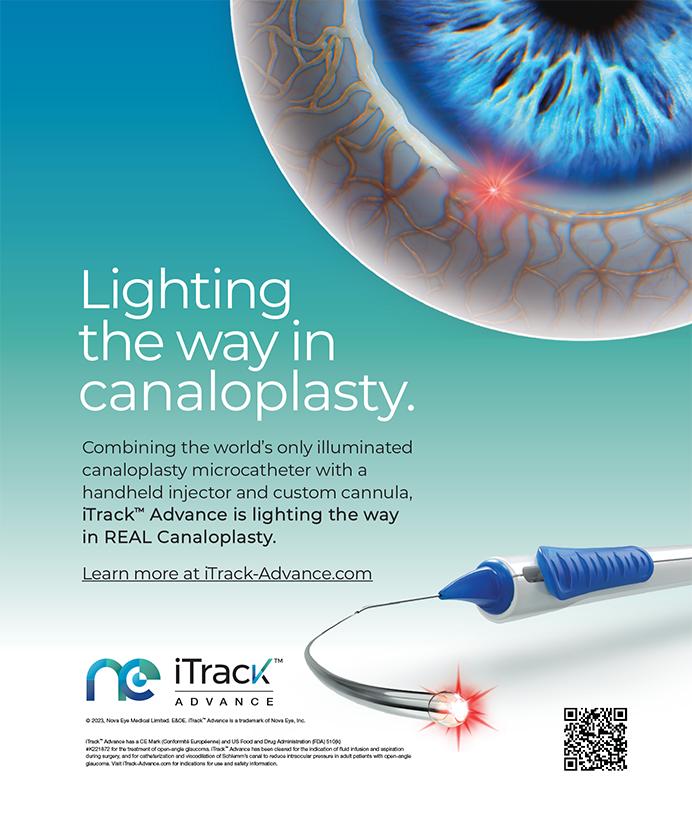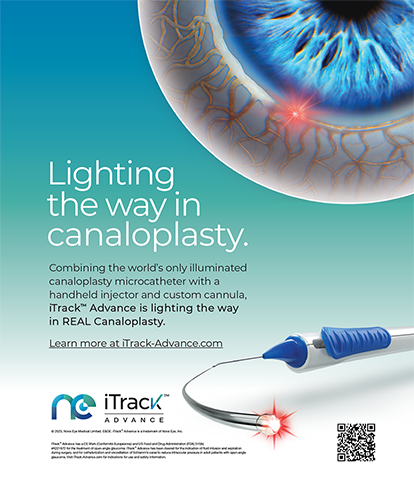Refractive Surgery | Jul 2005
The Verisyse Lens for Keratoconus
According to early results, this lens can benefit patients with keratoconus.
Majid Moshirfar, MD, FACS, and François J. Grégoire, MD
Keratoconus is a progressive disease that can lead to different levels of refractive error. To this day, treatment consists of contact lenses and corneal transplantation in severe cases, although there are no universally standardized intermediate treatment options.1 Our experience using the Verisyse lens (Advanced Medical Optics, Inc., Santa Ana, CA) is an alternative treatment in keratoconic patients.
EXPERIENCE
We analyzed patients between the ages of 40 and 50 years who had a long history of stable keratoconus and who were intolerant of contact lenses. Our patients suffered from severe myopia with a UCVA of count fingers. The spherical component ranged between -10.00 and -15.00D, although the cylindrical error was no more then 5.00D. Slit-lamp examination showed no corneal scarring, and the posterior pole was unremarkable. A few months following implantation of the Verisyse, our patients all had a BCVA of at least 20/30 and a UCVA of 20/40. Their manifest refraction was within 1.00D of plano. Each patient reported great satisfaction when compared with the results of penetrating keratoplasty in their other eye. The procedure caused insignificant changes in endothelial cell count, and keratometry remained unaffected.
IMPLANTATION OF THE VERISYSE
We used a superior approach in all patients. We created a conjunctival peritomy at the 12-o'clock position and made a 6-mm scleral incision. The power of the Verisyse lens was determined using each patient's most recent manifest refraction. We inserted the lens into the anterior chamber, and rotated and enclaved it at the 3- and 9-o'clock positions (Figures 1 and 2). We used 10–0 nylon sutures to close the incision. Patients received both a fourth-generation fluoroquinolone and topical steroids postoperatively.
RESULTS
Our limited experience thus far with the Verisyse lens for correcting myopia in patients with keratoconus is positive. These individuals were especially satisfied with their almost complete visual rehabilitation and the speed of their recovery.
Implanting a lens within the anterior chamber raises a concern for corneal decompensation.2 However, our results so far have shown no significant changes in endothelial cell density or keratometric values. Perhaps the larger anterior chamber found in patients with keratoconus helps minimize endothelial damage.
The Verisyse lens has been effective in our patients for correcting spherical error but not, as expected, for addressing the cylindrical component. We advise selecting patients with a high spherical-to-cylindrical component for more favorable results. Perhaps a toric IOL would be appropriate in cases where the cylinder is too high.3
Long-term complications of the Verisyse implant in our patients remain to be determined. Possible problems include glare, halos, increased IOP, and cataract formation.2 No complications have been reported yet by our patients.
We also considered the option of intrastromal corneal rings (Intacs; Addition Technology Inc., Des Plaines, IL). Intacs reinforce the cornea, but their ability to correct myopia is limited. Because our patients suffered from severe myopia, we chose Verisyse implantation. The use of Intacs in combination with a Verisyse lens may be an option in the future.4
CONCLUSION
We think of the Verisyse lens as an intermediate treatment option before penetrating keratoplasty. Although not all patients are automatic candidates for the lens procedure, we believe it would be useful to identify a subset of eligible patients. We have derived criteria such as corneal stability, lack of corneal scarring, low astigmatism, and middle age from our limited experience thus far. More thorough studies regarding the efficacy and predictability of this technique are still required.
Majid Moshirfar, MD, FACS, is Associate Professor of Ophthalmology and Director of the Cornea and Refractive Division at the John A. Moran Eye Center, University of Utah, Salt Lake City. He states that he holds no financial interest in any product or company mentioned herein. Dr. Moshirfar may be reached at (801) 585-3937; majid.moshirfar@hsc.utah.edu.
François J. Grégoire, MD, is a pre-residency research fellow at McGill University, Montreal, Canada. He states that he holds no financial interest in any product or company mentioned herein. Dr. Grégoire may be reached at (917) 714-2876; frankg13@yahoo.com.
1. Colin J, Velou S. Current surgical options for keratoconus. J Cataract Refract Surg. 2003;29:379-386.
2. Benedetti S, Casamenti V, Marcaccio L, et al. Correction of myopia of 7 to 24 diopters with the Artisan phakic intraocular lens: two-year follow-up. J Refract Surg. 2005;21:116-126.
3. Sauder G, Jonas JB. Treatment of keratoconus by toric foldable intraocular lenses. Eur J Ophthalmol. 2003;13:577-579.
4. Colin J, Velou S. Implantation of Intacs and a refractive intraocular lens to correct keratoconus. J Cataract Refract Surg. 2003;29:832-834.


